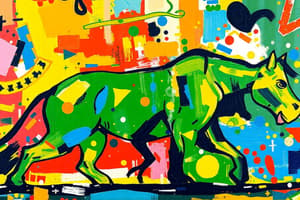Podcast
Questions and Answers
What is directional selection?
What is directional selection?
- Natural selection with no clear preferential direction
- Natural selection favoring individuals at one end of the phenotypic range (correct)
- Natural selection favoring individuals at both ends of the phenotypic range
- Natural selection favoring intermediate variants
What is disruptive selection?
What is disruptive selection?
Natural selection in which individuals at the upper and lower ends of the curve have higher fitness than those near the middle.
What is stabilizing selection?
What is stabilizing selection?
Natural selection that favors intermediate variants by acting against extreme phenotypes.
What are homologous structures?
What are homologous structures?
What are analogous structures?
What are analogous structures?
What are vestigial structures?
What are vestigial structures?
What is convergent evolution?
What is convergent evolution?
What is divergent evolution?
What is divergent evolution?
What is coevolution?
What is coevolution?
What is artificial selection?
What is artificial selection?
What is natural selection?
What is natural selection?
What is sexual selection?
What is sexual selection?
What is the order of classification?
What is the order of classification?
What is gene flow?
What is gene flow?
What is the bottleneck effect?
What is the bottleneck effect?
What is the founder effect?
What is the founder effect?
What is a mutation?
What is a mutation?
What is camouflage?
What is camouflage?
What is mimicry?
What is mimicry?
What is reproductive success?
What is reproductive success?
Flashcards are hidden until you start studying
Study Notes
Directional Selection
- Refers to natural selection where individuals with traits at one end of the phenotypic spectrum are favored.
- Results in increased survival or reproductive success for those individuals compared to others.
Disruptive Selection
- A type of natural selection where individuals at both extremes of the phenotypic curve have higher fitness.
- Favors organisms that exhibit traits that diverge from the average, promoting diversity within a population.
Stabilizing Selection
- Natural selection that favors intermediate phenotypes and acts against extreme variants.
- Helps maintain population stability by reducing variation in traits.
Homologous Structures
- Similar structures found in different species due to shared ancestry.
- Examples include similar bone structures in humans and whales, indicating evolutionary relationships.
Analogous Structures
- Body parts that perform similar functions but arise from different evolutionary origins.
- An example includes the wings of birds and insects, which serve the same function but have different structures.
Vestigial Structures
- Structures that exist in organisms but no longer serve their original purpose.
- Examples include the human appendix and whale pelvic bones, remnants of evolutionary history.
Convergent Evolution
- Occurs when unrelated species independently evolve similar traits due to adapting to similar environments.
- Results in analogous structures despite no recent common ancestry.
Divergent Evolution
- The process where closely related species evolve different traits adapting to varied environments.
- Leads to homologous structures among these species as they adapt differently over time.
Coevolution
- A reciprocal evolutionary process where two species influence each other's adaptation and evolution.
- Common in predator-prey relationships and mutualistic interactions between species.
Artificial Selection
- The intentional breeding of organisms with desirable traits by humans.
- Results in offspring that consistently exhibit selected traits, often seen in agriculture and pet breeding.
Natural Selection
- A foundational mechanism of evolution where organisms better adapted to their environment survive and reproduce.
- Drives the evolution of species over time, favoring advantageous traits.
Sexual Selection
- A form of natural selection based on mate choice and competition, influenced by heritable traits.
- Traits favored in this selection may enhance mating success rather than survival.
Order of Classification
- The hierarchical structure of biological classification includes: Domain, Kingdom, Phylum, Class, Order, Family, Genus, Species.
- Organizes and categorizes living organisms based on shared characteristics.
Gene Flow
- The movement and exchange of alleles between populations.
- Can introduce new genetic variation, impacting evolution and adaptation.
Bottleneck Effect
- A form of genetic drift occurring when a population's size is drastically reduced, often due to a natural disaster.
- Results in a loss of genetic diversity and a gene pool that may not represent the original population.
Founder Effect
- A genetic drift phenomenon where a small group from a larger population establishes a new population.
- This new population's gene pool may differ significantly from the original group, often leading to reduced genetic diversity.
Mutation
- A change in an organism's DNA sequence, which can result in new traits.
- Mutations are a primary source of genetic variation and can drive evolution.
Camouflage
- Adaptations that allow organisms to blend in with their surroundings, enhancing survival.
- Effective camouflage can protect species from predators by reducing visibility.
Mimicry
- The ability of one organism to resemble another, often harmful species.
- Provides an evolutionary advantage by deterring predators through mistaken identity.
Reproductive Success
- Refers to the likelihood that an individual will produce fertile offspring that survive to reproductive age.
- A key measure of fitness in evolutionary biology, influencing population dynamics and evolution.
Studying That Suits You
Use AI to generate personalized quizzes and flashcards to suit your learning preferences.




